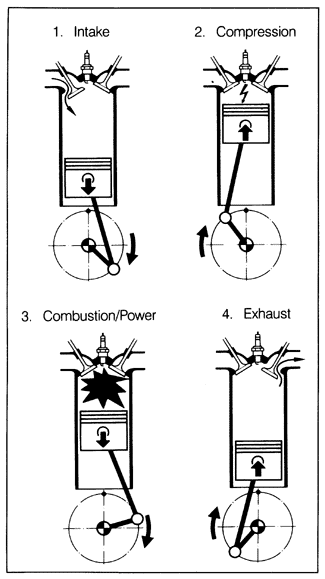1.2 EngineThe engine is the system which produces the power to move the car. It does so by burning a precise mixture of fuel and air, converting the fuel's stored energy into mechanical work, and delivering that mechanical work in a useful form. All of the Volkswagen engines covered in this manual are of reciprocating-piston design, and operate on the four-stroke cycle. The combustion of the air/fuel mixture creates tremendous pressure in a closed space above a piston, forcing the piston downward in its cylinder, and translating the energy of combustion into a mechanical force. The crankshaft converts each piston's motion into rotating motion, in much the same way that the up-and-down motion of a person's legs rotates the pedals of a bicycle. The power, transmitted in this rotary form, can then be used to move the car. The four-stroke cycle, the heart of how and why this all happens, is illustrated in Fig. 1-3.

Intake Stroke. The piston, traveling downward, creates low pressure inside the cylinder. With the intake valve open, this low pressure causes the fresh air/fuel mixture to rush in. When the piston is near the bottom of its travel the intake valve closes, leaving the cylinder sealed, full of air and vaporized fuel. Compression Stroke. As the piston begins its upward travel in the sealed cylinder, the air/fuel mixture is compressed to a small percentage of its original volume, creating a very flammable mixture in a very small space, referred to as the combustion chamber. Just before the piston reaches the top of its travel, the air/fuel mixture is ignited. In gasoline-fueled, spark-ignition engines, a spark plug causes ignition with a precisely timed spark. In diesel or compression-ignition engines, the air/fuel mixture is compressed so severely that the heat generated is, by itself, enough to cause ignition. In either case, the ignited air/fuel mixture begins to burn very rapidly. Combustion or Power Stroke. As the confined air/fuel mixture burns, temperature and pressure rise very rapidly, forcing the piston downward, turning combustion energy into work. Generally, the faster an engine runs and the more often this combustion cycle happens, the more power is produced. Exhaust Stroke. At the end of the power stroke, the piston is near the bottom of its travel and the cylinder is filled with the waste products of combustion which have little energy value and must be expelled to make way for a fresh load of air/fuel mixture. The exhaust valve opens and the piston, now traveling back upward, pushes the burned gasses out into the exhaust system. Near the top of the piston's travel, the exhaust valve closes, the intake valve opens, and the process begins anew with another intake stroke. |